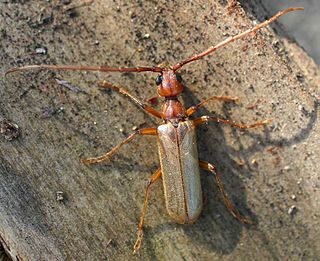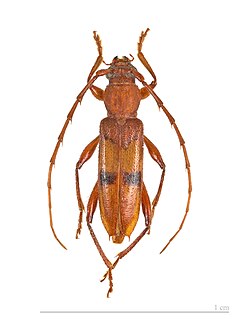Related Research Articles

The longhorn beetles are a cosmopolitan family of beetles, typically characterized by extremely long antennae, which are often as long as or longer than the beetle's body. In various members of the family, however, the antennae are quite short and such species can be difficult to distinguish from related beetle families such as the Chrysomelidae. The family is large, with over 26,000 species described, slightly more than half from the Eastern Hemisphere. Several are serious pests. The larvae, called roundheaded borers, bore into wood, where they can cause extensive damage to either living trees or untreated lumber. A number of species mimic ants, bees, and wasps, though a majority of species are cryptically colored. The rare titan beetle from northeastern South America is often considered the largest insect, with a maximum known body length of just over 16.7 cm (6.6 in). The scientific name of this beetle family goes back to a figure from Greek mythology: after an argument with nymphs, the shepherd Cerambus was transformed into a large beetle with horns.

Lamiinae, commonly called flat-faced longhorns, are a subfamily of the longhorn beetle family (Cerambycidae). The subfamily includes over 750 genera, rivaled in diversity within the family only by the subfamily Cerambycinae.

The Disteniidae are a small family of beetles in the superfamily Chrysomeloidea, traditionally treated as a group within the Cerambycidae.

The Vesperidae are a small family of beetles, normally classified within the family Cerambycidae, of heterogeneous aspect but all characterised by larval stages related to roots of herbaceous plants or trees

Clytini is a tribe of beetles in the subfamily Cerambycinae, containing the following genera:
Eburiini is a tribe of beetles in the subfamily Cerambycinae, synonymous with the tribe Heteropsini Lacordaire, 1868, containing the following genera:
Eburodacrys is a genus of beetles in the family Cerambycidae, containing the following species:

Elaphidiini is a tribe of beetles in the subfamily Cerambycinae, containing the following genera:
Heteropsini is a tribe of beetles in the subfamily Cerambycinae, synonymous with the tribe Eburiini Blanchard, 1845, containing the following genera:
Chrysoprasis is a genus of beetles in the family Cerambycidae, containing the following species:
Gnomidolon is a genus of beetles in the family Cerambycidae, containing the following species:
Compsibidion is a genus of beetles in the family Cerambycidae, containing the following species:
Heterachthes is a genus of beetles in the family Cerambycidae, containing the following species:
Neocompsa is a genus of beetles in the family Cerambycidae, containing the following species:
Tropidion is a genus of beetles in the family Cerambycidae, containing the following species:
Piezocerini is a tribe of beetles in the subfamily Cerambycinae, containing the following genera:
Gorybia is a genus of beetles in the family Cerambycidae, containing the following species:
Piezasteria helenae is a species of beetle in the family Cerambycidae. It was described by Martins in 1985.
Piezasteria sternalis is a species of beetle in the family Cerambycidae. It was described by Martins in 1976.
Aerenicini is a tribe of longhorn beetles of the subfamily Lamiinae.
References
- ↑ Bezark, Larry G. A Photographic Catalog of the Cerambycidae of the World Archived 2013-08-27 at the Wayback Machine . Retrieved on 22 May 2012.
| This Piezocerini article is a stub. You can help Wikipedia by expanding it. |